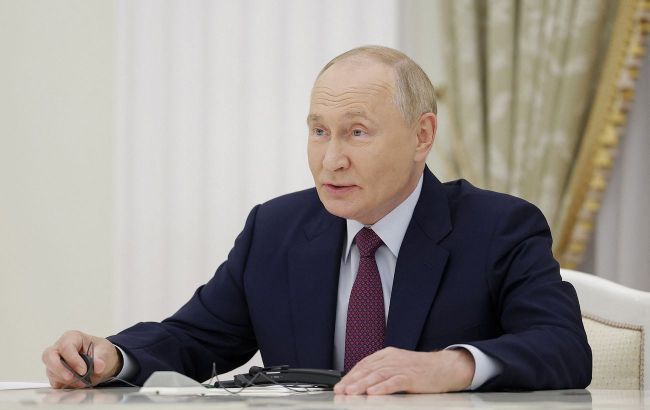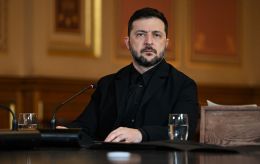Russia eyes Sumy as next target to build buffer zone, says ISW
 Russian President Vladimir Putin (photo: Getty Images)
Russian President Vladimir Putin (photo: Getty Images)
Russian President Vladimir Putin may be planning to capture the city of Sumy and parts of the Sumy region, but implementing such plans will not be easy, reports the Institute for the Study of War (ISW).
On May 20, Vladimir Putin visited Russia’s Kursk region, where he held a meeting with local officials. According to analysts, this move was likely aimed at laying the groundwork for renewed plans to capture the city of Sumy and illegally annex parts of the Sumy region.
The report recalls that during the meeting, the head of the Glushkovsky district, Pavel Zolotarev, addressed the Kremlin leader with a request to create a buffer zone on the territory of Ukraine’s Sumy region. Putin then asked how deep this buffer zone should be, to which Zolotarev responded that Russia should seize at least Sumy and that Russia must become bigger.
The city of Sumy is located approximately 25 kilometers from the international border. Establishing a buffer zone that includes the city would effectively prevent Ukraine’s Defense Forces from using tube artillery and tactical drones to strike Russian territory.
According to Western and Ukrainian sources, during the Ukrainian-Russian negotiations held on May 16 in Istanbul, the Russian delegation threatened to seize the Sumy region in order to create a so-called security zone.
Putin’s hidden ambitions
Experts at the Institute for the Study of War (ISW) are convinced that Vladimir Putin harbors territorial ambitions that extend beyond the regions already illegally occupied or annexed by Russia. The Kremlin leader is likely planning to use potential gains in the Sumy region as leverage in future peace negotiations to pressure Ukraine into ceding part of the territory.
“The Kremlin likely arranged the interaction at the May 20 meeting in order to frame Putin as an effective and engaged wartime leader by responding to Russian requests to further advance in the Sumy region and suggesting that Russia lay claim to more territory within Ukraine,” analysts suggest.
They also noted that Putin’s visit to the Kursk region was his first since Russia declared a military victory in the area on April 26. Despite official Kremlin claims of having fully expelled Ukrainian forces from the region, Ukraine’s Defense Forces continue to hold limited positions in the Kursk region. On May 21, Ukraine’s General Staff reported that active combat operations were still ongoing there.
Capturing Sumy – an unattainable goal
Moreover, the Institute for the Study of War (ISW) believes that Russian forces are unlikely to capture the city of Sumy in the short or medium term. Analysts cite the Russian army’s demonstrated inability over the past three years to quickly seize control of even significantly smaller Ukrainian settlements as the main reason.
Military analyst Kostiantyn Mashovets noted that the main assaults in the Sumy direction are being carried out by units of the 18th Motorized Rifle Division (11th Army Corps, Leningrad Military District) and the 72nd Motorized Rifle Division (44th AC, LMD). Elements of the 83rd Separate Airborne (VDV) Brigade are also likely involved, along with four to five regiments of motorized rifle and infantry troops from Russia’s mobilization reserve.
The Institute for the Study of War (ISW) believes that these forces are insufficient to capture a large city like Sumy, which had a pre-war population of 256,000. Russian troops have not demonstrated the capability to occupy major cities since the early months of the full-scale invasion.
Analysts also reminded that since July 2022, following the capture of Lysychansk in the Luhansk region, Russian forces have not managed to take control of a single Ukrainian city with a pre-war population of over 100,000.
The Institute for the Study of War (ISW) also noted that Lysychansk was captured through a slow and exhausting offensive, which depleted Russia’s offensive potential in eastern Ukraine by the summer of 2022, not as a result of an effective maneuver operation.
“Russian forces have since struggled to seize much smaller settlements in subsequent campaigns despite using larger numbers of forces, especially in eastern and northern Ukraine. Ukrainian officials have also previously expressed doubt that Russian forces would be able to conduct an effective offensive operation to seize Sumy,” the ISW report states.
War in Ukraine and Russia’s traps
On May 20, the Institute for the Study of War (ISW) reported that the Ukrainian Armed Forces had made gains in Russia’s Kursk region.
The institute stated there are no signs that Moscow is preparing to end the war in Ukraine.
ISW also warned that if Ukraine were to agree to the Kremlin’s preliminary conditions - recognizing as Russian the four occupied regions along with the illegally annexed Autonomous Republic of Crimea - Moscow might respond with even tougher territorial demands.

